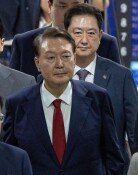Secret Nuclear Plant Found in North Korea
Secret Nuclear Plant Found in North Korea
Posted July. 20, 2003 21:38,
Strong evidence has emerged in recent weeks that North Korea has built a second, secret plant for producing weapons-grade plutonium, reported The New York Times yesterday.
Citing American and Asian officials with access to the latest intelligence on North Korea, the newspaper reported, "[The secret ambition of North Korea makes complicated] both the diplomatic strategy for ending the program and the military options if that diplomacy fails."
"Sensors set up on North Korea`s borders have begun to detect elevated levels of krypton 85. The computer analyses that track the gases as they are blown across the Korean Peninsula appeared to rule out the Yongbyon reprocessing plant as their origin," said the newspaper. Krypton 85 is a gas emitted as spent fuel is converted into plutonium.
The analysis strongly suggests, according to the New York Times, that the gas originated from a second, secret plant, perhaps buried in the mountains.
American intelligence officials say that they are wary about making any final judgments about the new evidence.
American officials have said they cannot verify that claim, though they confirm that sensors set up on North Korea`s borders have begun to detect elevated levels of krypton 85 along the DMZ.
"This takes a very hard problem and makes it infinitely more complicated," said one Asian official who has been briefed on the American intelligence and cited by The New York Times.
At the C.I.A. and the National Security Council, senior officials have long expressed concern that they could be missing something, that a second plant could be buried somewhere, though that would pose a number of technical challenges. Those fears have been heightened by reports from South Korean intelligence that one of its agents whose reliability is unknown reported the existence of a second plant, northeast of Yongbyon, reported The New York Times.
If it turns out that the current evidence is being properly interpreted, and a second plutonium plant also exists, President Bush may not even have the option that President Bill Clinton briefly considered in 1994: using a military strike or sabotage to prevent North Korea from producing significant amounts of weapons-grade material, predicts the newspaper.
The worst case is that the spent fuel rods have been moved to a previously undiscovered reprocessing plant, where the plutonium has been extracted and already shipped around the nation in five- to eight-kilogram packages for weapons production, added the daily.
In October, confronted with American evidence provided by US envoy James Kelly, North Korean officials admitted that they had clandestinely built a plant intended to produce uranium, another fuel for a bomb.
As to the New York Times report, White House Press Secretary Scott McClellan denied any confirmation and said that he usually does not comment on intelligence matters. Then, Spokesperson McClellan pointed out that last year the Untied States announced that Pyongyang has a secret nuclear program. Then, he criticized that North Korea has done quite a number of things that eventually ended in escalating the tension over the Peninsula.
On the other hand, a senior South Korean official did not deny the possibility of the existence of another plant. But he said, "I do not have any confirmed report, nor have ever heard about it." Then, he continued, "I don`t think it will affect the ongoing efforts by China to lead North Korea to dialog."







